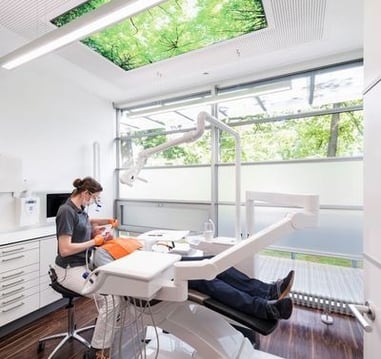Soundscaping in Dental Clinics
The ambiance of a dental clinic plays a critical role in shaping patient experiences and perceptions. While visual elements like interior design and lighting are often prioritized, the auditory environment, or soundscape, of a clinic is equally influential. Soundscaping in dental clinics, through deliberate sound design including music, sound masking systems, and other auditory elements, can significantly enhance patient privacy, comfort, and overall satisfaction.
The Role of Sound in Dental Clinics
Using Sound to Enhance Patient Experience
Dental clinics are inherently associated with specific sounds, some of which can induce anxiety or discomfort in patients. The whir of a drill, the buzz of equipment, and even conversations can escalate stress levels, contributing to a less than ideal patient experience. Soundscaping addresses these challenges by curating an auditory environment that not only masks potentially distressing sounds but also promotes a sense of calm and well-being.
Benefits of Soundscaping
• Reduced Anxiety and Stress: Carefully selected music and sounds can have a calming effect, reducing patient anxiety and stress levels.
• Enhanced Privacy: Sound masking systems help obscure conversations, ensuring patient and staff discussions remain confidential, thus enhancing privacy.
• Increased Focus and Efficiency for Staff: A well-designed soundscape can also benefit dental staff, reducing auditory distractions and enabling better focus and efficiency.
Elements of Sound scaping in Dental Clinics
The choice of music is paramount in setting the clinic's atmosphere. Soft, instrumental, or classical music is often preferred for its universal appeal and soothing properties. The volume and tempo should be moderate, providing a comforting background that doesn't overpower conversation.
Sound Masking Systems
Sound masking involves the addition of natural or artificial sound into an environment to cover up unwanted sound. In dental clinics, sound masking can help mask operational noises and muffled conversations, preserving the privacy and comfort of patients.
Nature Sounds and White Noise
Incorporating elements of nature, such as the sound of flowing water, rustling leaves, or gentle rain, can create a serene and therapeutic environment. White noise generators can also be effective in neutralizing jarring clinic noises, offering a continuous, soothing backdrop.
Technology Integration
Modern soundscaping solutions often integrate seamlessly with a clinic's existing technology infrastructure, allowing for centralized control of music, volume, and sound masking levels. This integration ensures that the auditory environment can be adjusted as needed throughout the day and in different areas of the clinic.
Implementing Soundscaping in Your Clinic


• Assess Your Current Soundscape: Take note of the existing sounds in your clinic, identifying any that may be potentially distressing or intrusive.
• Define Your Sound Goals: Decide on the atmosphere you wish to create. Should it be calming and serene, or perhaps more upbeat and energizing in certain areas?
• Improved Patient Experience: A pleasant auditory environment can transform the perception of wait times and treatment duration, leading to a more positive experience.
Music Selection
• Consult with Sound scaping Professionals: Professional sound designers or acoustic consultants can provide tailored solutions that fit your clinic's specific needs and layout.
• Pilot and Adjust: Implement your soundscaping strategy in phases, allowing for feedback from patients and staff to make necessary adjustments.
Conclusion
The strategic use of sound in dental clinics can profoundly impact patient and staff experiences. By carefully designing the soundscape, clinics can create a more welcoming, private, and relaxing environment that not only enhances patient satisfaction but also supports staff in providing the best possible care. In the increasingly competitive field of dental services, soundscaping may well be the subtle difference that sets a clinic apart.
